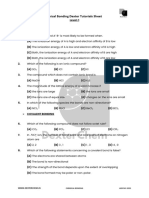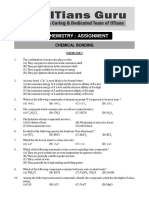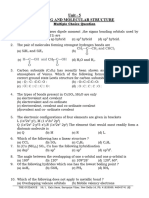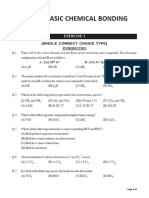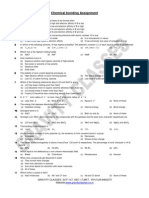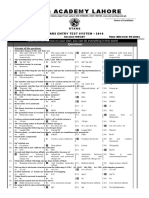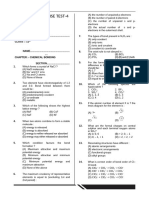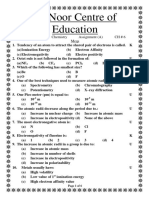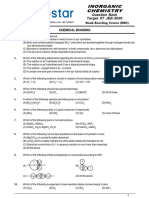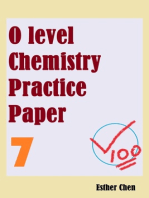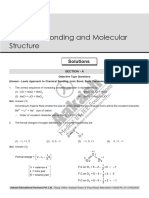CH 3 Xi
CH 3 Xi
Uploaded by
Khurram AwanCopyright:
Available Formats
CH 3 Xi
CH 3 Xi
Uploaded by
Khurram AwanOriginal Title
Copyright
Available Formats
Share this document
Did you find this document useful?
Is this content inappropriate?
Copyright:
Available Formats
CH 3 Xi
CH 3 Xi
Uploaded by
Khurram AwanCopyright:
Available Formats
CHEMISTRY PRACTICE TEST FOR MCQ’S
CHAPTER NO: 03
THEORIES OF CHEMICAL BONDING
i. The is ______ % in ionic character
(A) 72 (C) 92
(B) 100 (D) 0
ii. A bond is formed between two atoms in which the shared pair of electrons is
donated by one of the bonded atoms called
(A) Ionic bond (C) Hydrogen bond
(B) Co-ordinate covalent bond (D) none of these
iii. The number of bond in oxygen (O2) molecule is:
(A) one sigma and one pi-bond (C) two sigma bonds
(B) two pi-bonds (D) one sigma and two pi-bond
iv. During the formation of a stable chemical bond
(A) Energy is release (C) Energy is absorbed
(B) Energy neither released nor absorbed (D) none of these
v. In which pair the molecular shape is same
(A) NF3 and H2O (C) NH3 and H2S
(B) H2O and H2S (D) CH4 and PH3
vi. Which one has one lone pair on the central atom?
(A) H2O (C) H2S
(B) BCl3 (D) PH3
vii. The lone pair - lone pair repulsion is ______ than bond pair – bond pair repulsions.
(A) Greater (C) Less
(B) Equal to (D) None of these
viii. The molecules containing four electron pairs with no lone pair to form a shape:
(A) Regular tetrahedron (C) Regular triangle
(B) Trigonal pyramidal (D) Regular linear
ix. Which of the following statement is not correct?
(A) double bonds is stronger than single bond (C) sigma bond is stronger than pi bond
(B) triple bonds is shorter than double bonds (D) sigma bond is weaker than pi bond
x. The bond angles in molecules containing four electron Paris, with one lone pair &
three bond pairs in NF3 is:
(A) 105.5o (C) 104.5o
(B) 102o (D) 120o
xi. The shape of benzene molecule is explain by:
(A) Sp3 orbital hybridization (C) Sp2 orbital hybridization
(B) Sp orbital hybridization (D) None of these
xii. The number of coordinate covalent bond in NH4+ is
(A) One (C) three
(B) Two (D) four
xiii. The electron cloud density is symmetrical along the bond axis in:
(A) Sigma bond (C) Pi bond
(B) Both of these (D) None of these
PROF.KHURRAM SHAHBAZ CHEM PCAPC
CHEMISTRY PRACTICE TEST FOR MCQ’S
CHAPTER NO: 03
THEORIES OF CHEMICAL BONDING
xiv. Which is the example of AB4 TYPE?
(A) BH3 (C) AlCl3
(B) SnCl2 (D) NF3
xv. Element X is strongly electropositive and Y is strongly electronegative. Both are
univalent the compound formed would be:
(A) X+Y– (C) X–Y+
(B) X – Y (D) X Y
xvi. If ‘A” represent central atom and ‘B’ represent bond pair and ‘L’ lone pair which
of the following represent the Trigonal pyramidal geometry:
(A) AB2L (C) AB3L
(B) AB2L2 (D) ABL2
xvii. Which one is the correct statement?
(A) A sigma bond is formed when two s-orbitals overlap
(B) A pi bond is formed when two p-orbitals end to end overlap
(C) A bond is weaker than bond
(D) A bond is only formed after the formation of bond.
xviii. Which of the following molecules contain eight bonding electrons?
(A) C2H4 (C) CO2
(B) BF3 (D) H2S
xix. A bond is formed by the overlap of
(A) S – S orbital (C) S – P orbital
(B) P – P orbital in end to end fashion (D) P – P orbitals in side wise manner
xx. The shape of CO2 molecule is similar to:
(A) H2S (C) BeCl2
(B) SO2 (D) SnCl2
xxi. The total number of bond is present in C2H4 is:
(A) Three (C) Five
(B) Four (D) Six
xxii. The bond angle in ethane molecule is :
(A) 109.50 (C) 1200
(B) 107.50 (D) 1800
xxiii. Which of the following show minimum bond angle :
(A) H2O (C) H2S
(B) NH3 (D) NF3
PROF.KHURRAM SHAHBAZ CHEM PCAPC
CHEMISTRY PRACTICE TEST FOR MCQ’S
CHAPTER NO: 03
THEORIES OF CHEMICAL BONDING
xxiv. Which of the following molecule have greater percentage of s character in the
hybrid orbital used?
(A) CH4 (C) C2H2
(B) C2H6 (D) C2H4
xxv. Which of the following species has unpaired electrons in anti-bonding molecular
orbitals:
+2 2
A. O2 C. N2
B. B2 D. F2
xxvi. Arrange the following molecules in decreasing bond length.
A) O2 > O2– > O2+ > O22- C) O22- > O2– > O2+ > O2
B) O22- > O2– > O2 > O2+ D) O2– > O2+ > O22- > O
xxvii. 3. Bond Order of O2, F2, N2 respectively are __________:
A. +1, +2, +3 C. +2, +3, +1
B. +2, +1, +3 D. +3, +2, +1
xxviii. Arrange the following molecules in the order of increasing stability.
A) N2+ < N2 < N2– < N22- C) N22- < N2– = N2+ < N2
B) N22- < N2– < N2 < N2+ D) N2 < N2+ = N2– < N22-
xxix. The relative energies of molecular orbitals in increasing order have been found to
be as follows.
(σ1s) < (σ*1s) < (σ2s) < (σ*2s) < [(π2py)(π2pz)] < (σ 2px) < [(π*2py)(π*2pz)] < (σ*2px)
A) For O2 to Ne2 C) For H2 to Ne2
B For H2 to N2 D) For N2 to Ne2
xxx. According to Molecular Orbital Theory, the shape and size of a molecular orbital
depends upon _________:
A) Shape and size of the combining atomic orbitals
B) Numbers of the combining atomic orbitals
C) Orientation of the combining atomic orbitals
D) All of the mentioned
PROF.KHURRAM SHAHBAZ CHEM PCAPC
You might also like
- Caie As Level Chemistry 9701 Theory v1Document30 pagesCaie As Level Chemistry 9701 Theory v1Noora MubarakNo ratings yet
- Chapter 6 Chemical Bonding McqsDocument13 pagesChapter 6 Chemical Bonding McqsHaider Jalal100% (5)
- Chemical Bonding ExerciseDocument3 pagesChemical Bonding Exercisearorakavya2006No ratings yet
- 60ac8cf54847930011783523_##_Chemical Bonding Pra_230409_212527Document5 pages60ac8cf54847930011783523_##_Chemical Bonding Pra_230409_212527thegenericprogrammerNo ratings yet
- Chemical Bonding YbNDjRw9OBIPRJOwDocument45 pagesChemical Bonding YbNDjRw9OBIPRJOwpijika6908No ratings yet
- Xi CH#04Document4 pagesXi CH#04papukhan67zkqNo ratings yet
- Chemical Bonding Sheet With Answer Key and JEE Adv PYQs 1671903747405Document60 pagesChemical Bonding Sheet With Answer Key and JEE Adv PYQs 1671903747405Vansh JainNo ratings yet
- CH # 5, 6, 8 1st Year, 27-02-2016Document1 pageCH # 5, 6, 8 1st Year, 27-02-2016Qaisar RiazNo ratings yet
- Chemical Bonding _ BKQ Notes __ Lakshya JEE 2025Document15 pagesChemical Bonding _ BKQ Notes __ Lakshya JEE 2025iitianadistarNo ratings yet
- 6772c758f09b1ee19633b567_##_Chemical Bonding __ BKQ NotesDocument15 pages6772c758f09b1ee19633b567_##_Chemical Bonding __ BKQ Notesa8201507No ratings yet
- Chemical Bonding & Molecular StructureDocument15 pagesChemical Bonding & Molecular Structureakashcho2211No ratings yet
- TOPIC WISE REVIEW CPP-II-CB & S-BLOCK - PMDDocument10 pagesTOPIC WISE REVIEW CPP-II-CB & S-BLOCK - PMDSaksham PanghalNo ratings yet
- Chemical Bonding & Molecular Structure Tutorial - 1Document4 pagesChemical Bonding & Molecular Structure Tutorial - 1shauryaNo ratings yet
- 5_6325647878161171555Document29 pages5_6325647878161171555vikramprajapatpwNo ratings yet
- Chemical Bonding (13th)Document21 pagesChemical Bonding (13th)Broany XNo ratings yet
- IOC Miscellaneous Question BankDocument15 pagesIOC Miscellaneous Question Bankamit tiwariNo ratings yet
- Classification Bonding and Molecular StructureDocument7 pagesClassification Bonding and Molecular StructurearshadumerkhanNo ratings yet
- Test Chemical BondingDocument3 pagesTest Chemical Bondingdevansh dewanNo ratings yet
- Chemical Bonding - 12thDocument27 pagesChemical Bonding - 12thbadarsha25No ratings yet
- Chemical Bonding-CPPDocument5 pagesChemical Bonding-CPPDevulapalli AnshumanNo ratings yet
- Chemcial Bonding - Class TestDocument4 pagesChemcial Bonding - Class TestBhavya SomaiyaNo ratings yet
- 11-CHEMISTRY-TERM 1 (2022-23)Document4 pages11-CHEMISTRY-TERM 1 (2022-23)jnv33rdscienceNo ratings yet
- Chem ch4Document17 pagesChem ch4Winter GamingNo ratings yet
- ChemicalBonding - D13 Sep 2023Document3 pagesChemicalBonding - D13 Sep 2023viditpsvzNo ratings yet
- Set 1 Part 1 Chemical BondingDocument2 pagesSet 1 Part 1 Chemical Bondingswagsahaj44No ratings yet
- Assignment 1 - Chemical BondingDocument8 pagesAssignment 1 - Chemical BondingArshad Ansari100% (1)
- Exercise - 1: Basic Objective Questions: Ionic BondsDocument7 pagesExercise - 1: Basic Objective Questions: Ionic BondsNavita Rajgaria0% (1)
- Bonding and Molecular Structure Final by Pragya 07.10.10Document25 pagesBonding and Molecular Structure Final by Pragya 07.10.10kumarm78No ratings yet
- Chemical Bonding SPECIAL ASSIGNMENTDocument25 pagesChemical Bonding SPECIAL ASSIGNMENTprexa indiaNo ratings yet
- (Chemical Bonding)Document2 pages(Chemical Bonding)abhishektiwary0007No ratings yet
- 35 Chemical Bonding (1-35)Document35 pages35 Chemical Bonding (1-35)kishanshivakantguptaNo ratings yet
- Chemical Bonding - Quiz 01072015Document4 pagesChemical Bonding - Quiz 01072015Shan RudraNo ratings yet
- Kota Worksheet Chemical BondingDocument16 pagesKota Worksheet Chemical BondingYash GargNo ratings yet
- Chemical Bonding - VBTDocument4 pagesChemical Bonding - VBTVarsha YadavNo ratings yet
- Chemical BondingDocument19 pagesChemical BondingAman AntilNo ratings yet
- Grade 11 Chemistry Midterm QP 2022-23Document7 pagesGrade 11 Chemistry Midterm QP 2022-23prabhu rupNo ratings yet
- Chemical BondingDocument32 pagesChemical BondingsudisumasubisureshNo ratings yet
- Adobe Scan Aug 25, 2024Document13 pagesAdobe Scan Aug 25, 2024shreeprakash1620No ratings yet
- T3 (Ch5+6) KeyDocument6 pagesT3 (Ch5+6) KeyIlyasNo ratings yet
- 3. Chemical Bonding ( Basic)Document38 pages3. Chemical Bonding ( Basic)shindeanmol9876No ratings yet
- Worksheet (MCQ) KTR D19 Oct 2024Document17 pagesWorksheet (MCQ) KTR D19 Oct 2024tulip.1538411No ratings yet
- Chemical BondingDocument9 pagesChemical Bondingarpitbhadauriya073No ratings yet
- ORGANIC ACT1 _EXAMDocument3 pagesORGANIC ACT1 _EXAMMary Mae VitorNo ratings yet
- Periodic Table & Chemical BondingDocument3 pagesPeriodic Table & Chemical Bondingvivaanpashte07No ratings yet
- Chemical BondingDocument33 pagesChemical BondingacguptaclassesNo ratings yet
- 1 Chemistry 1st Year Chapter 6 FullDocument3 pages1 Chemistry 1st Year Chapter 6 Fullmahar zafar100% (1)
- Chemical Bonding 2010Document3 pagesChemical Bonding 2010Anirud ThyagharajanNo ratings yet
- Chemical_bonding_and_redox_1722488397Document6 pagesChemical_bonding_and_redox_1722488397parag.cricketNo ratings yet
- Test - 1 Single Choice QuestionsDocument61 pagesTest - 1 Single Choice QuestionsGod is every whereNo ratings yet
- Chemical Bonding - 2Document10 pagesChemical Bonding - 2prexa indiaNo ratings yet
- Stars Academy Lahore: QuestionsDocument2 pagesStars Academy Lahore: QuestionsMemoona GullNo ratings yet
- C4 Home AssignmentDocument2 pagesC4 Home AssignmentMemoona GullNo ratings yet
- 6 Chemical Bonding 2Document17 pages6 Chemical Bonding 2Akn NanthanNo ratings yet
- 28.07.24 Xi Chemical Bonding QuestionDocument4 pages28.07.24 Xi Chemical Bonding QuestionEverest AnnaduraiNo ratings yet
- Chemistry 1-6 PaperDocument2 pagesChemistry 1-6 PaperdosutneelumNo ratings yet
- 1st Year Chemistry RTA CH # 06 OKDocument6 pages1st Year Chemistry RTA CH # 06 OKahast5755No ratings yet
- Chemical BondingDocument22 pagesChemical BondingAbhishek KumarNo ratings yet
- Chemical Bonding Question Bank-20200420174204769702Document12 pagesChemical Bonding Question Bank-20200420174204769702aryankmsingh22No ratings yet
- CH 2Document4 pagesCH 2Khurram AwanNo ratings yet
- Unit 7 "S and P Block and Transition EleDocument21 pagesUnit 7 "S and P Block and Transition EleKhurram AwanNo ratings yet
- Open Chapter 06 SOLUTIONS (Short Syllabus)Document11 pagesOpen Chapter 06 SOLUTIONS (Short Syllabus)Khurram AwanNo ratings yet
- CH 1Document2 pagesCH 1Khurram AwanNo ratings yet
- CH 2Document2 pagesCH 2Khurram AwanNo ratings yet
- Bab 01 - The Basics Bonding and Molecular StructureDocument131 pagesBab 01 - The Basics Bonding and Molecular Structurecindy wiriaatmadjaNo ratings yet
- 8.7: Exceptions To The Octet Rule: Exception 1: Species With Odd Numbers of ElectronsDocument8 pages8.7: Exceptions To The Octet Rule: Exception 1: Species With Odd Numbers of ElectronsHarshal BandkarNo ratings yet
- ACJC H2 CHEM P1 Questions (Worked Solutions)Document26 pagesACJC H2 CHEM P1 Questions (Worked Solutions)Trí VũNo ratings yet
- Molecular GeometryDocument85 pagesMolecular GeometryKeri Gobin SamarooNo ratings yet
- 2022-JEE Advanced Booster Test-1 SolutionsDocument13 pages2022-JEE Advanced Booster Test-1 SolutionsAccount 1No ratings yet
- PE Revision SheetDocument11 pagesPE Revision Sheetsatvikarora8crisNo ratings yet
- 11.chemical BondingDocument10 pages11.chemical BondingAtif KhanNo ratings yet
- CHAPTER 4: Chemical BondingDocument25 pagesCHAPTER 4: Chemical BondingHikmaNo ratings yet
- Chemicalbonding Ex 1Document19 pagesChemicalbonding Ex 1Manish ParmarNo ratings yet
- Hybridization: Definition: The Phenomenon of Mixing Up of Atomic Orbitals ofDocument48 pagesHybridization: Definition: The Phenomenon of Mixing Up of Atomic Orbitals ofIke Jayson Rollon100% (1)
- Lewis Acid Behavior of SF4 Synthesis Characterizat PDFDocument12 pagesLewis Acid Behavior of SF4 Synthesis Characterizat PDFNandini GattadahalliNo ratings yet
- Lewis Structure Spring 2014Document7 pagesLewis Structure Spring 2014Mohamed DahmaneNo ratings yet
- Review 5.3-5.4Document5 pagesReview 5.3-5.4David RheeNo ratings yet
- Chemistry Report 1Document6 pagesChemistry Report 1Athirah BidinNo ratings yet
- V B TDocument12 pagesV B TAshish KatariaNo ratings yet
- 3.2.5-1 - 2 Introducing Transition MetalsDocument57 pages3.2.5-1 - 2 Introducing Transition Metalsmilksheikh2004No ratings yet
- Chemistry Bonding AnswerDocument19 pagesChemistry Bonding AnswerPeaceNo ratings yet
- 7.p Block Elements NewDocument22 pages7.p Block Elements NewMehak GandhiNo ratings yet
- Introductory Chemistry Atoms First 5th Edition Russo Solutions Manual 1Document10 pagesIntroductory Chemistry Atoms First 5th Edition Russo Solutions Manual 1seanjacksonkwzgnbxift100% (54)
- Metal-Π Complexes:: Metal Carbonyls: Structure and BondingDocument53 pagesMetal-Π Complexes:: Metal Carbonyls: Structure and BondingDonné van HeerdenNo ratings yet
- Physical / Inorganic Chemistry (BT 303) : Course Co-Ordinator Dr. Mahera Moin DCOB, Dow University of Health SciencesDocument78 pagesPhysical / Inorganic Chemistry (BT 303) : Course Co-Ordinator Dr. Mahera Moin DCOB, Dow University of Health SciencesMed RynnNo ratings yet
- CHM 101 Atoms, Molecules and Structure - BangbadeDocument36 pagesCHM 101 Atoms, Molecules and Structure - Bangbadedddoowoon97No ratings yet
- 11 Petrucci10e CSM 231011 075845Document55 pages11 Petrucci10e CSM 231011 075845hilwa.hayatiNo ratings yet
- Nitrosyl Complexes in Inorganic Chemistry Biochemistry and Medicine I PDFDocument241 pagesNitrosyl Complexes in Inorganic Chemistry Biochemistry and Medicine I PDFAdonilson FreitasNo ratings yet
- Parishram Academy: Name of Topic: GOC Subject: Chemistry Class: XI Batch:-Max. Marks. 180Document35 pagesParishram Academy: Name of Topic: GOC Subject: Chemistry Class: XI Batch:-Max. Marks. 180jaiswalbebo024No ratings yet
- Zumdahl Chemprin 6e CSM Ch14Document36 pagesZumdahl Chemprin 6e CSM Ch14Salamah SakraniNo ratings yet
- CLS Aipmt-18-19 XI Che Study-Package-1 SET-2 Chapter-4 PDFDocument32 pagesCLS Aipmt-18-19 XI Che Study-Package-1 SET-2 Chapter-4 PDFMridul Dhingra100% (1)
- June 2021 MS - Paper 1 Edexcel Chemistry As-LevelDocument29 pagesJune 2021 MS - Paper 1 Edexcel Chemistry As-Levelbeyofar644No ratings yet
- Chemical BondingDocument19 pagesChemical BondingDINESH reddyNo ratings yet




